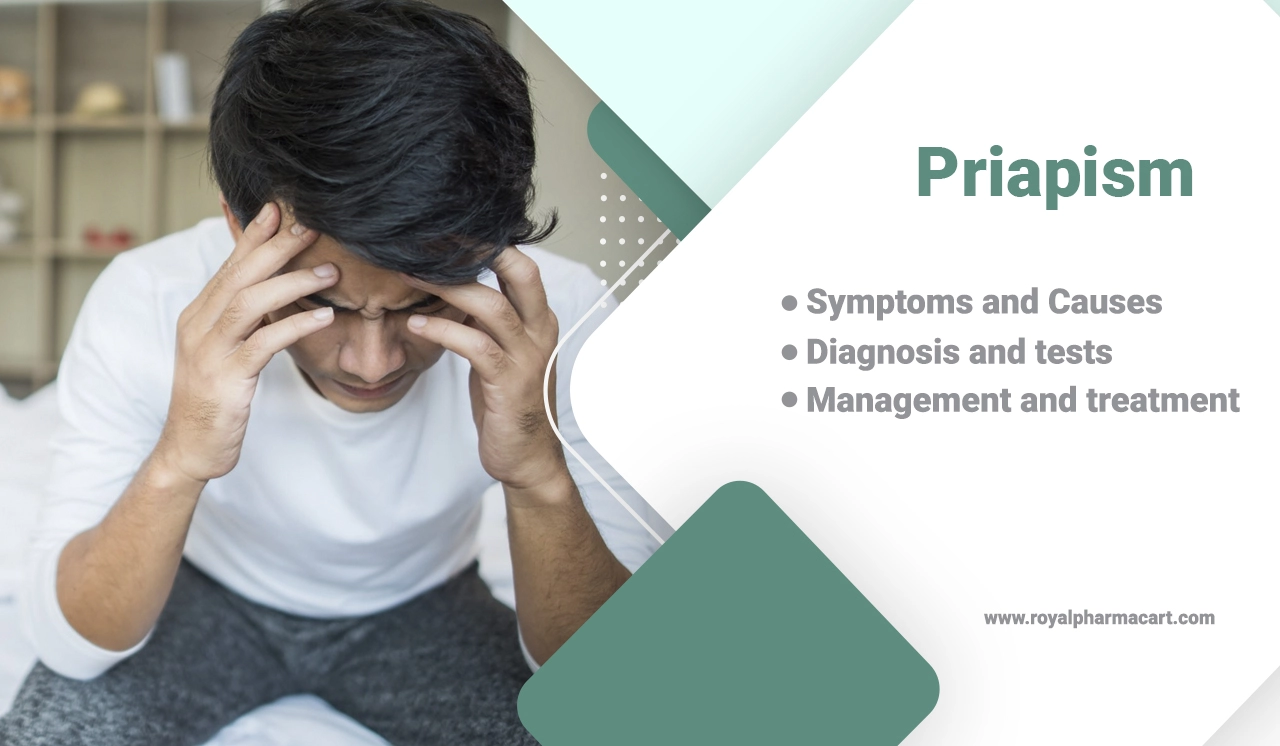Health & Wellness, Personal Care
Priapism
Priapism | Symptoms and Causes | Diagnosis and tests | Management and treatment
A priapism is an often-painful erection over a long period of time on the penis. Penile blood is trapped and does not flow from the penile arteries.
Often unrelated to sexual activity or continuing well beyond sexual activity. It can be a serious condition as there is a risk of permanent tissue damage.
Here we explore the treatment options for prolonged erection and some of the more common causes. It also describes the symptoms and types of priapism.
What is priapism?
A priapism is usually a painful permanent erection that lasts more than 4 hours and occurs without sexual stimulation. This condition occurs when the blood in the penis becomes trapped and unable to flow out. If the condition is not treated immediately, it can lead to scarring and permanent erectile dysfunction.
Persistent erectile dysfunction can occur at any age, including newborns. However, it generally affects men of two different ages: 5-10 years old and 20-50 years old.
There are two types of Prolonged Erection (Priapism): 1) Low flow and 2) High flow.
• Low flow erection: This is the result of blood being trapped in the erection chamber. It often occurs without a known cause in otherwise healthy men, but it also affects men with sickle cell disease, leukemia (blood cancer) or malaria.
• High-output priapism: This is rare and usually painless. This is the result of a ruptured artery due to damage to the penis or perineum (the area between the scrotum and the anus) and prevents blood from flowing normally through the penis.
What are the Symptoms of Priapism (prolonged erection)?
The main symptom of priapism is a prolonged erection. Other symptoms depend on the type of priapism that is occurring.
Symptoms of ischemic prolonged erection include:
• Penis pain that gets worse over time
• Erection with soft penis tip
Non-ischemic prolonged erection is usually painless, and the erection is not fully established.
What causes priapism?
There are several different causes of priapism. These include:
Medications: Certain medications can affect the nerves in the body, including the penis. Usually, these nerves widen the arteries that supply the penis, allowing the penis to become congested and erect.
Drugs: Some recreational uses of drugs have been associated with prolonged erection, such as stimulants, marijuana, cocaine, and ecstasy.
Injury: Penile artery damage can result from damage to the penis or perineum and can interfere with blood flow or drainage. It is a common cause of non-ischemic prolonged erection.
Sickle cell anemia: An abnormal shape of red blood cells can cause penile arteries to become blocked and cause prolonged erection. According to the Cleveland Clinic, “About 42% of adults with pseudocythemia will eventually develop priapism.”
Cancer: Rarely, prolonged erection can occur with the growth of certain types of cancer. Especially if they block the supply of arteries or nerves to the penis and cause blockages.
Blood disorders: Rarely, certain blood disorders can cause prolonged erection. In particular, salaemia, chronic leukemia and multiple myeloma are associated with persistent erectile dysfunction.
The causes vary and all ages can be affected, but prolonged erection is most common in infants between 5 and 10 years old and in young adult males between 20 and 50 years old. affect.
if you have ed problem then take a cenforce 200, cenforce 100 and cenforce 150, take it any one required as your suggestions.
How is priapism (prolonged erection) diagnosed?
If you have priapism, it is important to seek treatment immediately. Tell your doctor:
• How long have you been erected?
• How long an erection usually lasts.
• The use of drugs or drugs, whether legal or illegal. Be honest with your doctor. Drug use is particularly important because marijuana and cocaine have been linked to prolonged erection.
• If post-traumatic prolonged erection has occurred in this area of the body.
Your doctor will review your medical history and perform a physical exam to help determine the cause of prolonged erection.
After the physical exam is complete, your doctor will measure the blood gases in the bloodstream of your penis. During this test, a small needle is inserted into the penis, blood is drawn, and then sent to a laboratory for analysis. This gives clues to the type of prolonged erection, the duration of the disease and the extent of the damage.
Cure and treatments of Priapism
Treatment for priapism depends on the type and cause. Your doctor will perform an evaluation and determine if it is ischemic or non-ischemic and a possible cause.
If the penis has been erected for less than 4 hours, decongestants that reduce blood flow to the penis may be effective in reducing the erection. If the erection lasts 4-6 hours, medications are usually effective.
After 6 hours or if medication fails, further action is required. These include:
• Ice: Applying ice to the penis or perineum can reduce swelling and non-ischemic attacks.
• Aspiration: The penis is numbed with medication and the doctor inserts a needle to drain the accumulated blood. This procedure usually provides quick relief from pain and swelling.
• Surgery: If ice packs and suction fail, surgery may be needed to restore normal blood flow to the penis. Inserting a shunt or extra passage can help drain excess blood and restore circulation and can be used for ischemic prolonged erection.
If an artery ruptures or is damaged during surgery, surgeons may ligate or tie it off to reduce blood flow. It is more effective in non-ischemic priapism.
References
American Urological Association. Management of prolonged erection. (https://www.auanet.org/guidelines/priapism-guideline) Accessed10/18/2019.
AlDallal, S., AlDallal, N., & Alam, A. (2016, December 5). Sickle cell-induced ischemic prolonged erection. Cogent Medicine, 3(1), 1268357
https://www.cogentoa.com/article/10.1080/2331205X.2016.1268357.pdf
Cherian, J., Rao, A. R., Thwaini, A., Kapasi, F., Shergill, I. S., & Samman, R. (2006, February). Medical and surgical management of prolonged erection. Postgraduate Medical Journal, 82(964), 89-94
https://www.ncbi.nlm.nih.gov/pmc/articles/PMC2596691/

